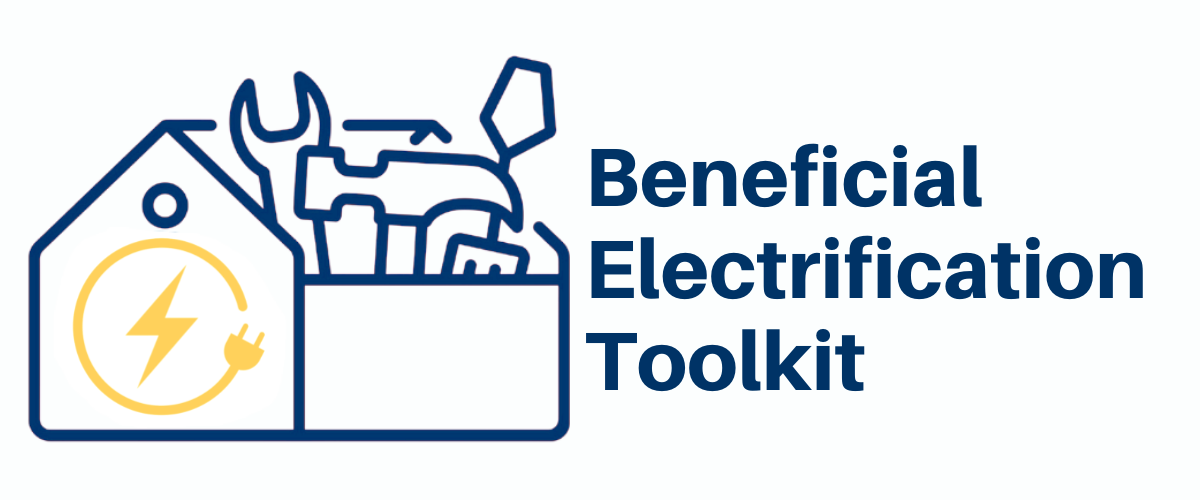
Beyond Utility Incentives
Why It Matters
The Inflation Reduction Act and the Infrastructure Investment and Jobs Act offer multiple rebates, tax credits, and grants that rural stakeholders, like households, businesses, and schools can utilize in their decarbonization efforts. Additionally, utilities can point their members and customers in the direction of these options available to them. You will find two distinct sections below: buildings and transportation.
Please note: The Beneficial Electrification Toolkit is not a tax advisor and should not be taken as professional advice.
Vehicle Incentives - Individuals
Clean Vehicle Credit (30D) for New Electric Vehicles
In 2022, Congress modified and extended the clean vehicle federal tax credit through 2032 to incentivize consumers with up to $7,500 to purchase battery electric vehicles and plug-in hybrids. One of the major changes was to eliminate the per-manufacturer cap for the tax credit, allowing vehicles from GM, Tesla, and Toyota to once again be eligible. Several new eligibility requirements, including “Made in America” provisions, are determined on a model-by-model basis. This narrowed the official list of eligible vehicles, but it is expected to expand as manufacturers move to meet domestic manufacturing and sourcing requirements.
Credit for Previously-Owned Clean Vehicles (25E)
The Credit for Previously-Owned Clean Vehicles provides a federal tax credit through 2032 for qualified pre-owned clean vehicles purchased on or after January 1, 2023.
The base credit is 30 percent of the total cost of the electric car or plug-in hybrid vehicle, up to $4,000. Starting in 2024, the tax credit is transferable only to the dealer at the point of sale. Eligible previously owned vehicles can be checked here.
Alternative Fuel Infrastructure Tax Credit (30C)
The EV Infrastructure Tax Credit, extended through 2032, covers 30% of the costs of "qualified alternative fuel vehicle refueling property"—including resident electric vehicle supply equipment—up to $1,000. Eligible homes must be in rural areas or low-income census tracts. The credit was also amended to specifically cover bidirectional charging equipment that allows electric vehicles to send energy back into the grid.
Vehicle Incentives - Fleet Operators
Commercial Clean Vehicle Credit (45W)
Businesses and tax-exempt organizations, including rural electric cooperatives and nonprofits, that buy an electric car to replace a diesel- or gas-powered vehicle can claim a 30% federal tax credit.The maximum credit is $7,500 for qualified vehicles with gross weight ratings (GVWRs) under 14,000 pounds and $40,000 for all other vehicles. There is no limit on the number of credits a business can claim, and the credits are non-refundable.
Alternative Fuel Infrastructure Tax Credit (30C)
The alternative fuel infrastructure tax credit provides commercial entities with a 30% federal tax credit, up to $100,000 per unit, to install electric charging stations. Bidirectional charging equipment is also eligible. To take advantage of the full credit, businesses must meet prevailing wage and apprenticeship program requirements. If these requirements are not met, then the tax credit is reduced to 6%.The tax credit is available as “direct pay” to local and state governments, nonprofits, rural electric cooperatives, tribal governments, and other non-exempt entities. It is also transferable.
Clean School Bus Program
The U.S. Environmental Protection Agency (EPA) Clean School Bus Program provides $5 billion through September 30, 2026, to replace existing school buses with electric and other zero-emission bus options. In October 2022, the EPA announced the first round of awards, granting $913 million to fund 2,468 new school buses across 391 school districts. Electric buses accounted for 95% of the awards. EPA also announced a waitlist made up of 1,400 school districts’ requests for more than 9,000 additional buses. Moving forward, the EPA plans to hold two application windows per year through 2026.
Clean Heavy-Duty Vehicle Program
This EPA program provides $1 billion for grants and rebates to state and local governments, tribes, and nonprofit school transportation associations to expand the use of electric and other zero-emission heavy-duty vehicles (Class 6 or 7). $400 Million is set aside for communities in non-attainment areas. Eligible activities include the incremental costs of replacing existing heavy-duty vehicles, purchasing and operating necessary charging infrastructure, workforce development and training, and planning and technical activities.
Diesel Emission Reduction Act (DERA)
Information for funding regarding the reduction of harmful diesel emissions, especially from school buses, is available for state and tribal governments through the EPA. Resources can be found here.
EV Charging Infrastructure
There is $7.5 billion in federal funds available for charging infrastructure nationwide. Of that total, $2.5 billion over five years for charging and fueling infrastructure grants help rural areas and low-income neighborhoods install new charging infrastructure for electric vehicles and clean alternative fuel vehicles. An additional $2.5 billion for formula funding is distributed via state DOTs, and the final $2.5 billion for funding is distributed via competitive grants.
Residential Building Incentives
Home Energy Rebate Programs
The U.S. Department of Energy (DOE) will disburse $8.8 billion to states for the Home Electrification and Appliance Rebate Program and the Home Efficiency Rebate Program. Each state, territory, and tribe will administer its own program according to broad program rules set by DOE. States, territories, and tribes are applying for their share of program funds to set up programs.
Households can potentially participate in both programs as well as other federal grants and rebates, but not for the same single upgrade. Subject to applicable rules, households can combine federal rebates with incentives from manufacturers, utilities, and states, as well as with financing programs like on-bill financing.
Energy Efficiency Home Improvement Tax Credit (25C)
The Energy Efficiency Home Improvement Tax Credit is for single-family homeowners to install eligible energy efficiency and electrification energy upgrades. Beginning in 2023, single-family homes can receive a 30% federal tax credit of up to $3,200 for energy upgrades to their primary residence. The tax credit is nonrefundable and cannot be rolled over to the next tax year, which means that the person claiming the tax credit must have enough tax liability to receive it. The tax credit can be combined with the Home Energy Rebate Programs for upgrades in the same home.
Commercial Building Incentives
Commercial Buildings Energy-Efficiency Tax Deduction (179D)
The 179D tax deduction program supports commercial building owners who choose to improve the energy efficiency of their building systems. Owners and tenants, in some cases, can pursue installing new, qualifying systems in their buildings. Additionally, if the installation is done upon federal, state, or local government property, the 179D tax deduction may be taken by the person primarily responsible for the system’s design, as in the case of an energy-as-a-service company.
Starting in 2023, nonprofit organizations can benefit from 179D when deciding to renovate a building with energy efficiency improvements, like lighting and insulation, as well as HVAC equipment and other envelope retrofits that result in energy savings of at least 25 percent. Under the law, nonprofits can pass the deduction through an “allocation letter” to a taxpaying person responsible for the project design and construction, like a designer, engineer, building contractor, or architect. Using the deduction, the tax liable person can offer lower project costs to the nonprofit organization.
See more information in this article.
Multifamily Affordable Housing Improvements
The Green and Resilient Retrofit Program (GRRP) is now available from Housing and Urban Development (HUD). This new multifamily housing program aims to improve affordable housing, primarily through grants, loans, and loan modifications. Eligible projects must seek to “improve energy or water efficiency, enhance indoor air quality or sustainability, implement the use of zero-emission electricity generation, low-emission building materials or processes, energy storage, or building electrification strategies, or address climate resilience, of an eligible property.”
Clean Ports Program
This new federal program will provide $3 billion in competitive grants over five years to port authorities and state and local governments with jurisdiction over a port to purchase or install zero-emission equipment or technology for use at one or more ports. This may include utilizing zero-emission port vehicles, cleaning up shore power sources, and improving pollution mitigation practices. Visit the program page here.
School Electrification Incentives
Support for school initiatives and infrastructure goes beyond electric school buses and even beyond strict definitions of electrification. There is federal funding available to support schools across the country in improving their energy use and efficiency, maintenance, lighting, and air quality. The White House has assembled and released a helpful guide to direct interest toward the specific program being offered. Beyond direct financial assistance to improve school districts, DOE is supporting schools with technical assistance to pursue upgrades under the Efficient and Healthy School Investments program.
Funding for Rural Businesses and Agencies
Here are USDA programs that offer financing assistance to rural utilities or to the farm/business to apply directly.
Rural Energy for America Program (REAP)
REAP has been expanded and provides more than $2 billion for renewable energy systems and energy efficiency improvement grants for agricultural producers and rural small business owners through 2031.
Environmental Qualities Incentives Program (EQIP)
EQIP provides technical and financial assistance to producers to address natural resource concerns and deliver environmental benefits such as improved water and air quality, conserved ground and surface water, increased soil health, and reduced soil erosion and sedimentation, improved or created wildlife habitat, and mitigation against drought and increasing weather volatility.
Rural Business Development Grant (RBDG)
This is a competitive grant program designed to support targeted technical assistance, training, and other activities leading to the development or expansion of small and emerging private businesses in rural areas that have fewer than 50 employees and less than $1 million in gross revenues.
Community Facilities Direct Grant and Loan
This loan and grant program financial resources to various rural applicants, including rural electric cooperatives, hospitals, fire departments, child care centers, transitional housing, and many more.
Visit the BE Toolkit’s Program Funding page to learn about additional options.







